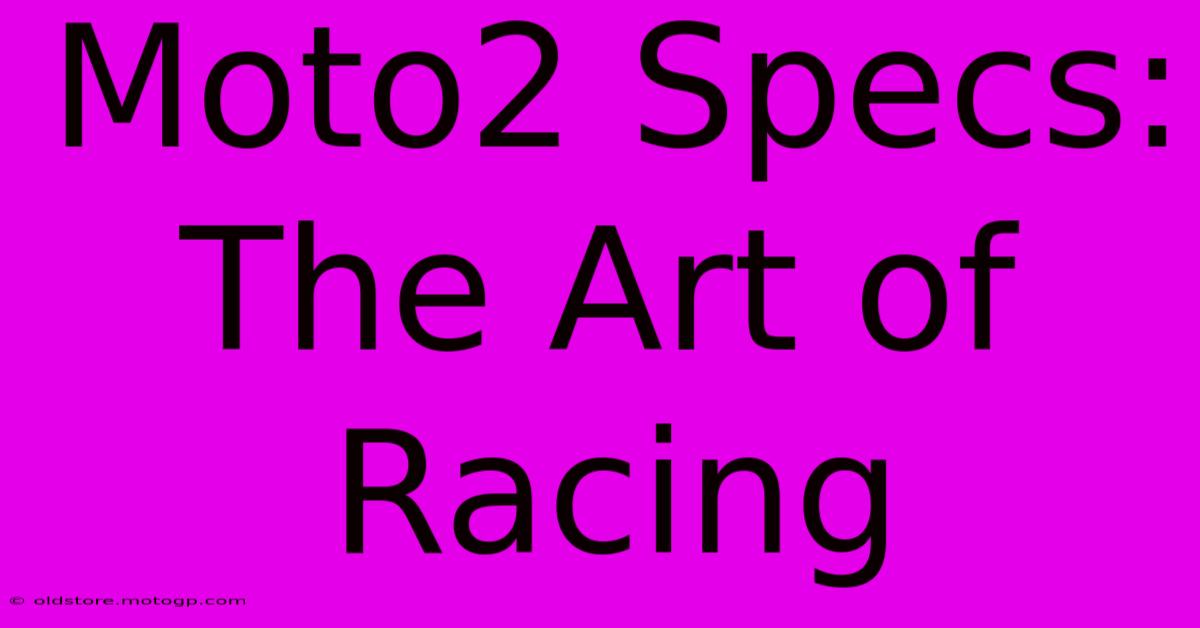Moto2 Specs: The Art Of Racing

Table of Contents
Moto2 Specs: The Art of Racing
Moto2. The name conjures images of breathtaking speeds, precise maneuvers, and the raw talent of some of the world's best motorcycle racers. But what makes these machines so special? Beyond the thrilling races, lies a fascinating world of technical specifications and engineering prowess. This article delves into the intricate details of Moto2 specifications, revealing the art behind the racing.
Understanding the Moto2 Formula: A Standardized Approach
Unlike MotoGP, where manufacturers compete with their own bespoke engines, Moto2 boasts a unified engine platform. This standardization levels the playing field, emphasizing rider skill and team strategy over sheer engine power. This crucial element ensures closer racing and makes the championship incredibly competitive. The standard Triumph 765cc triple-cylinder engine is a key differentiator, providing a consistent power delivery that's both exhilarating and challenging to master.
The Triumph Engine: A Powerhouse of Precision
The heart of every Moto2 machine is the Triumph 765cc inline-three cylinder engine. This engine, based on the Street Triple RS, has been meticulously developed for racing. While the exact horsepower figures are closely guarded, it delivers exceptional performance within the specified regulations. The smooth power delivery and manageable characteristics are critical for riders pushing their limits lap after lap. Key aspects include:
- High Revving Capabilities: The engine is engineered to operate at extremely high RPMs, maximizing power output within the regulatory constraints.
- Exceptional Torque: Despite its high-revving nature, the engine also delivers substantial torque, aiding acceleration out of corners.
- Lightweight Construction: Engineers have prioritized weight reduction to improve handling and agility on the track.
Beyond the Engine: Chassis and Components
The engine is only part of the equation. The chassis, suspension, and other components significantly impact a rider's performance. Teams have considerable freedom to optimize these aspects, leading to diverse setups tailored to specific rider styles and track characteristics.
Chassis Dynamics: Fine-tuning for Performance
Teams meticulously fine-tune the chassis geometry, aiming for a balance between stability and agility. Adjustments to things like rake and trail can dramatically alter a bike's handling characteristics. The use of high-quality materials like carbon fiber contributes to overall weight reduction, enhancing performance.
Suspension Systems: Absorbing the G-forces
Moto2 bikes utilize sophisticated suspension systems, often featuring fully adjustable Öhlins forks and shocks. These allow for fine-tuning of compression and rebound damping, adapting the bike's setup to various track conditions. The ability to precisely control suspension behavior is critical for maintaining stability and speed through corners.
Aerodynamics: Cutting Through the Wind
While not as extensively developed as in MotoGP, aerodynamics still play a significant role in Moto2. Teams carefully consider the design of fairings and other aerodynamic components to minimize drag and maximize stability at high speeds. Even small aerodynamic gains can translate into significant advantages on race day.
The Human Element: Rider Skill and Team Strategy
While the technical specifications are critical, the human element remains paramount in Moto2. The skill and precision of the rider, combined with the strategic decisions made by the team, are what ultimately determine success. Data analysis, meticulous preparation, and seamless teamwork are crucial for maximizing performance.
Conclusion: A Symphony of Engineering and Skill
Moto2 racing represents a remarkable blend of sophisticated engineering and exceptional human skill. The standardized engine ensures a level playing field, while the freedom in chassis and component selection allows for nuanced optimization. The result is a thrilling spectacle of close racing, where the slightest advantage can make all the difference. Understanding the Moto2 specs provides a deeper appreciation for the art and science of this incredible racing discipline.

Thank you for visiting our website wich cover about Moto2 Specs: The Art Of Racing. We hope the information provided has been useful to you. Feel free to contact us if you have any questions or need further assistance. See you next time and dont miss to bookmark.
Featured Posts
-
Austin F1 Qualifying For The Checkered Flag
Feb 24, 2025
-
Lot F Insider Secrets For Circuit Of The Americas Parking
Feb 24, 2025
-
Lub Si Cota Breaking Free From Limiting Beliefs
Feb 24, 2025
-
Moto Gp Live Interviews And Highlights On Tnt Sports
Feb 24, 2025
-
Moto Gp Sprint Results The Pursuit Of Perfection
Feb 24, 2025
